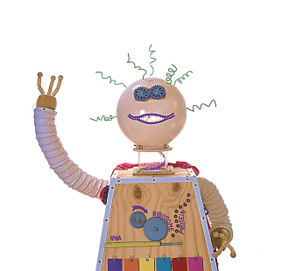Synthetic biology is an emerging field of research that has potential for huge impact through both societal and economic benefits. The processes and details that need to be understood to appreciate the potential for synthetic biology require a basic understanding of how genes are regulated and transcribed to make proteins and products.
DNA Dave - the DNA transcription and translation robot.
Science festivals provide an opportunity for scientists to engage with a mixed audience, that typically spend 5-10 minutes visiting individual stands. The SAW trust, together with OpenPlant, came up with the idea to build an interactive robot that could help people understand the processes involved with DNA transcription and translation; this resulted in the birth of “DNA Dave”. Dave’s head resembles the nucleus of a cell, where the double stranded DNA can be found. The DNA strands then split and one strand is transcribed into single stranded RNA that leaves the nucleus via pores, in this case represented by DNA Dave’s neck. The RNA enters the cell cytoplasm (DNA Dave’s body) and is translated by the ribosomes which produce a sequence of amino acids; this process is represented by the turning of a cog that causes a sequence of lights to flash.
Having taken the DNA Dave robot to many science festivals, it has proven to be an engaging, approachable robot, that not only helps to explain the key synthetic biology principles of DNA transcription and translation, but through doing so, enables new conversations linking key principles to scientific applications.
DNA Dave at the Cambridge Science Festival 2017
One common question that we were asked at science festivals by school teachers, was whether the DNA Dave robot was available for schools to hire. This got the ball rolling on the next DNA Dave project.
With the help of the Biomakers fund, we have set out to convert the original DNA Dave robot into a training robot and create a cross disciplinary workshop for schools, in which the schools learn to build their own DNA Dave. To achieve this, the current robot will be modified to become an effective training tool, where by all the internal workings of the robot will be accessible for hands on training. Moreover, the current micro-controller (an Arduino board) will be exchanged for a board more commonly used in schools, a micro:bit board.
DNA Dave’s current Arduino uno break out board which will be replaced by a Micro:bit board
For our launch workshop we plan on producing a workshop template, a “how to” coding and build guide, a DNA Dave CAD drawing, and materials suitable for a robot build. Students will then design and build their own DNA Dave robot using the how to guide and materials supplied, as well as receiving support and advise from us during the process.
The main principle of the workshop and robot design is to familiarise students with the process of DNA transcription and translation, but students will be given the opportunity to develop skills across coding, technical design, electronics and biology. In addition to this, all students who take part will be exposed to subjects and topics that they may not already have an interest in and therefore potentially develop an interest in a new field.
At the end of the robot builds, we hope to gather all the new DNA Dave’s to an event during the next Norwich Science Festival where schools can showcase their designs. This showcase event will also serve as an opportunity for schools to discuss their project experiences, ideas and introduce the project to new schools.
Check out our hackster profile to keep up to date with our project.
- Dr Jenni Rant, Ioannis Tamvakis and Sami Stebbings




